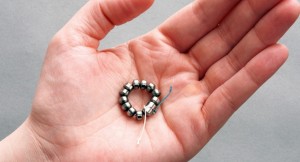-
Cardiovascular
TUESDAY Q & A: New treatment may be option for those with GERD
DEAR MAYO CLINIC: I saw a story on the news about magnets being used to treat patients with GERD. Is this treatment safe? How does it work? I have taken prescription drugs for GERD for years and would love to not need medication anymore.
ANSWER: The treatment you heard about is a new therapy now available for people with persistent gastroesophageal reflux disease (GERD). 
It involves placing around the lower end of the esophagus a device that looks like a bracelet and is made up of magnetic beads. The device allows food to pass into the stomach, but prevents acid and other digestive juices in the stomach from getting up into the esophagus.
Normally a ring of muscle, called the lower esophageal sphincter, located at the bottom of the esophagus and the top of the stomach stays closed when you are not eating. This keeps the acid that is in your stomach out of your esophagus. If those muscles become weak or relax when they shouldn’t, acid can work its way into the esophagus. This acid reflux leads to the painful burning and regurgitation symptoms known as heartburn. The combination of acid reflux with heartburn, when they last over time, is GERD.
In the past, treatment for GERD has relied mainly on medicine to reduce stomach acid. But that is not always effective in controlling the disorder. This new treatment is intended for people whose GERD symptoms continue to flare up even when they take a daily dose of medication.
Effective control of GERD is important because, if left untreated, excessive acid can damage the esophagus and lead to a precancerous condition known as Barrett’s esophagus and, eventually, to esophageal cancer.
The purpose of putting the bracelet device around the esophagus is to reinforce the lower esophageal sphincter. The device is placed in the same area as that ring of muscle. The magnetic force between each bead holds the bracelet snug around the esophagus.
When a person with this device swallows food, pressure within the esophagus pushes the food down. When it reaches the bracelet of magnetic beads, the pressure causes the magnetic force between each bead to lessen. The bracelet then pops open, food passes into the stomach, and the magnetic force pulls the bracelet closed again.
Surgery to implant the device usually lasts one to two hours. The procedure is minimally invasive and typically requires only an overnight hospital stay. Recovery takes about a week. Some individuals report difficulty swallowing with the device in place. But for most people, that fades over time. The bracelet is designed to be a permanent solution for GERD. So unless there are problems, it is not removed.
A recent study, published in The New England Journal of Medicine, followed 100 people who had this treatment for three years. Ninety-two of the people in the study reported fewer GERD symptoms. Eighty-seven percent of the study participants were able to completely stop using acid-lowering medications, and 94 percent reported being satisfied with the treatment.
In March 2012, the Food and Drug Administration approved the device for treatment of GERD in the United States. If you have GERD and daily antacid is not enough to control your symptoms, this treatment may be a good fit for you. Talk to your doctor or contact a physician who specializes in GERD to learn more. — C. Daniel Smith, M.D., Surgery, Mayo Clinic, Jacksonville, Fla.







